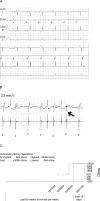Follow up and optimisation of cardiac pacing
- PMID: 16103575
- PMCID: PMC1769065
- DOI: 10.1136/hrt.2004.054528
Follow up and optimisation of cardiac pacing
Figures



Similar articles
-
The increasing use of mode-switching.Pacing Clin Electrophysiol. 1997 Dec;20(12 Pt 1):3012-3. doi: 10.1111/j.1540-8159.1997.tb05479.x. Pacing Clin Electrophysiol. 1997. PMID: 9455770 No abstract available.
-
Interventricular Pacemaker-Mediated Tachycardia during Biventricular Pacing.Pacing Clin Electrophysiol. 2015 May;38(5):645-50. doi: 10.1111/pace.12400. Epub 2014 May 4. Pacing Clin Electrophysiol. 2015. PMID: 24797447 No abstract available.
-
Effects of physiologic pacing versus ventricular pacing.N Engl J Med. 2000 Nov 9;343(19):1418. N Engl J Med. 2000. PMID: 11183886 No abstract available.
-
[No evidence of positive effects of pacemaker use in paroxysmal atrial fibrillation].Lakartidningen. 2005 May 30-Jun 5;102(22):1722-6. Lakartidningen. 2005. PMID: 15987049 Review. Swedish.
-
Pacing and atrial fibrillation.Can J Cardiol. 1996 Jan;12 Suppl A:36A-39A. Can J Cardiol. 1996. PMID: 8598000 Review. No abstract available.
Cited by
-
Clinical features, follow-up, and reprogramming of patients with pacemaker in a secondary care center.Hippokratia. 2018 Apr-Jun;22(2):75-79. Hippokratia. 2018. PMID: 31217679 Free PMC article.
-
Patient Perceptions and Quality of Life in Pacemaker Recipients.J Innov Card Rhythm Manag. 2021 Nov 15;12(11):4769-4779. doi: 10.19102/icrm.2021.121103. eCollection 2021 Nov. J Innov Card Rhythm Manag. 2021. PMID: 34858671 Free PMC article.
-
Drive-Through Pacing Clinic: A Popular Response to the COVID-19 Pandemic.JACC Clin Electrophysiol. 2021 Jan;7(1):128-130. doi: 10.1016/j.jacep.2020.09.026. Epub 2020 Oct 10. JACC Clin Electrophysiol. 2021. PMID: 33478706 Free PMC article. No abstract available.
-
A Contactless Sensor for Pacemaker Pulse Detection: Design Hints and Performance Assessment.Sensors (Basel). 2018 Aug 18;18(8):2715. doi: 10.3390/s18082715. Sensors (Basel). 2018. PMID: 30126178 Free PMC article.
References
-
- Fraser JD, Gillis AM, Irwin ME, et al. Guidelines for pacemaker follow-up in Canada: a consensus statement of the Canadian working group on cardiac pacing. Can J Cardiol 2000;16:355–63. ▸ National Canadian guidelines on pacemaker follow up providing comprehensive details on minimum requirements. - PubMed
-
- Hayes DL, Naccarelli GV, Furman S, et al. NASPE training requirements for cardiac implantable electronic devices: selection, implantation and follow-up. Pace Clin Electrophysiol 2003;26:1556–62. - PubMed
-
- Erdinler I, Akyol A, Okmen E, et al. Long term follow-up of pacemakers with and autocapture pacing system. Jpn Heart J 2003;43:631–41. - PubMed
-
- Nowak B. Pacemaker stored electrograms: teaching us what is really going on in our patients. Pacing Clin Electrophysiol 2002;25:838–49. ▸ A comprehensive review of stored electrograms and their clinical interpretation. - PubMed
-
- Huikuri H. Effect of stored electrograms on management in the paced patient. Am J Cardiol 2000;86 (suppl) :101K–3K. ▸ Review article concentrating on evaluation of symptomatic and asymptomatic arrhythmias recorded in pacemakers. - PubMed
Publication types
MeSH terms
LinkOut - more resources
Full Text Sources
